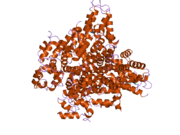Biology:LRDD
 Generic protein structure example |
Leucine-rich repeats and death domain containing, also known as LRDD or p53-induced protein with a death domain (PIDD), is a protein which in humans is encoded by the LRDD gene.[1]
Function
The protein encoded by this gene contains a leucine-rich repeat and a death domain. This protein has been shown to interact with other death domain proteins, such as Fas (TNFRSF6)-associated via death domain (FADD) and MAP-kinase activating death domain-containing protein (MADD), and thus may function as an adaptor protein in cell death-related signaling processes. The expression of the mouse counterpart of this gene has been found to be positively regulated by the tumor suppressor p53 and to induce cell apoptosis in response to DNA damage, which suggests a role for this gene as an effector of p53-dependent apoptosis. Three alternatively spliced transcript variants encoding distinct isoforms have been reported.[1] Besides its pro-apoptotic function it may also be involved in DNA repair as part of a protein complex formed together with the catalytic subunit of DNA-PK (DNA-PKcs)and caspase 2.
References
Further reading
- "LRDD, a novel leucine rich repeat and death domain containing protein". Biochim. Biophys. Acta 1478 (2): 280–8. 2000. doi:10.1016/S0167-4838(00)00029-7. PMID 10825539.
- "Pidd, a new death-domain-containing protein, is induced by p53 and promotes apoptosis". Nat. Genet. 26 (1): 122–7. 2000. doi:10.1038/79102. PMID 10973264.
- "Generation and initial analysis of more than 15,000 full-length human and mouse cDNA sequences". Proc. Natl. Acad. Sci. U.S.A. 99 (26): 16899–903. 2003. doi:10.1073/pnas.242603899. PMID 12477932.
- "Complete sequencing and characterization of 21,243 full-length human cDNAs". Nat. Genet. 36 (1): 40–5. 2004. doi:10.1038/ng1285. PMID 14702039.
- "The PIDDosome, a protein complex implicated in activation of caspase-2 in response to genotoxic stress". Science 304 (5672): 843–6. 2004. doi:10.1126/science.1095432. PMID 15073321.
- "Transcriptome characterization elucidates signaling networks that control human ES cell growth and differentiation". Nat. Biotechnol. 22 (6): 707–16. 2005. doi:10.1038/nbt971. PMID 15146197.
- "The Status, Quality, and Expansion of the NIH Full-Length cDNA Project: The Mammalian Gene Collection (MGC)". Genome Res. 14 (10B): 2121–7. 2004. doi:10.1101/gr.2596504. PMID 15489334.
- "Towards a proteome-scale map of the human protein-protein interaction network". Nature 437 (7062): 1173–8. 2005. doi:10.1038/nature04209. PMID 16189514.
- "PIDD mediates NF-kappaB activation in response to DNA damage". Cell 123 (6): 1079–92. 2006. doi:10.1016/j.cell.2005.09.036. PMID 16360037.
- "Functional connection between p53 and caspase-2 is essential for apoptosis induced by DNA damage". Oncogene 25 (41): 5683–92. 2006. doi:10.1038/sj.onc.1209569. PMID 16652156.
- "Upon intracellular processing, the C-terminal death domain-containing fragment of the p53-inducible PIDD/LRDD protein translocates to the nucleoli and interacts with nucleolin". Biochem. Biophys. Res. Commun. 349 (4): 1329–38. 2006. doi:10.1016/j.bbrc.2006.08.176. PMID 16982033.
- "Autoproteolysis of PIDD marks the bifurcation between pro-death caspase-2 and pro-survival NF-κB pathway". EMBO J. 26 (1): 197–208. 2007. doi:10.1038/sj.emboj.7601473. PMID 17159900.
- "Crystallization and preliminary X-ray crystallographic studies of the oligomeric death-domain complex between PIDD and RAIDD". Acta Crystallographica Section F 63 (Pt 3): 229–32. 2007. doi:10.1107/S1744309107007889. PMID 17329820.
- "The expression of p53-induced protein with death domain (Pidd) and apoptosis in oral squamous cell carcinoma". Br. J. Cancer 96 (9): 1425–32. 2007. doi:10.1038/sj.bjc.6603745. PMID 17437012.


